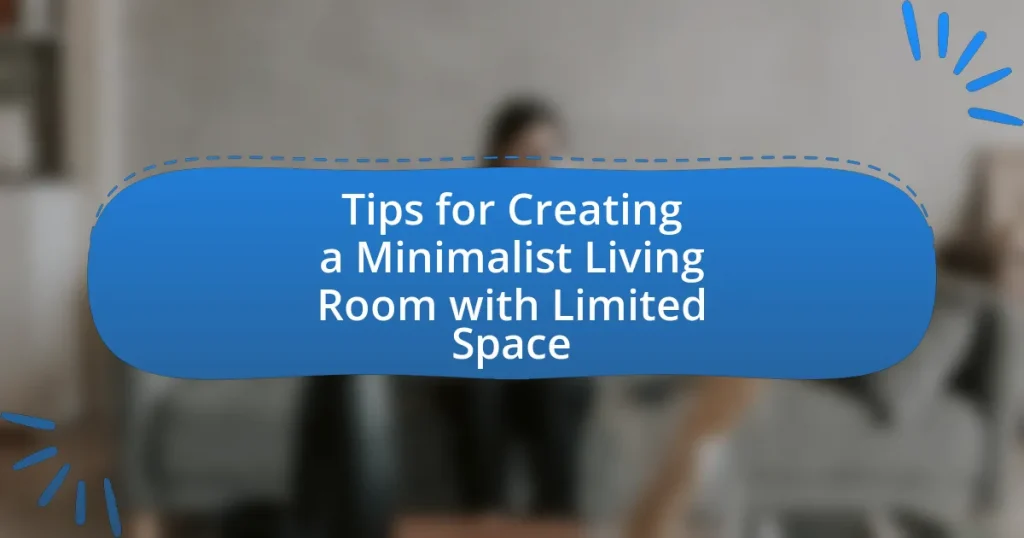The article focuses on effective strategies for creating a minimalist living room, particularly in spaces with limited dimensions. It outlines key principles such as simplicity, functionality, and intentionality in design, emphasizing the importance of decluttering and selecting multifunctional furniture. The article also discusses how color schemes can enhance the perception of space, the significance of space optimization, and practical tips for maintaining a minimalist aesthetic over time. Additionally, it highlights common mistakes to avoid and the role of personal style in achieving a balanced minimalist environment.

What are the key principles of a minimalist living room?
The key principles of a minimalist living room include simplicity, functionality, and intentionality in design. Simplicity is achieved by reducing clutter and limiting decorative items, which creates a clean and open space. Functionality emphasizes the use of furniture that serves multiple purposes, such as a coffee table with storage or a sofa bed. Intentionality involves selecting each item purposefully, ensuring that every piece contributes to the overall aesthetic and utility of the room. These principles are supported by the minimalist philosophy, which advocates for living with less to enhance quality of life and reduce distractions.
How does minimalism influence living room design?
Minimalism influences living room design by prioritizing simplicity, functionality, and open space. This design philosophy encourages the use of fewer furniture pieces, neutral color palettes, and a focus on essential items, which creates a serene and uncluttered environment. Research indicates that minimalist spaces can reduce stress and enhance well-being, as they eliminate visual distractions and promote a sense of calm. By incorporating multifunctional furniture and maximizing natural light, minimalism effectively utilizes limited space while maintaining an aesthetically pleasing and organized living area.
What are the essential elements of minimalist design?
The essential elements of minimalist design include simplicity, functionality, and a focus on space. Simplicity is achieved through the use of clean lines and a limited color palette, often featuring neutral tones. Functionality emphasizes the importance of each item serving a purpose, reducing clutter and distractions. A focus on space involves maximizing open areas and natural light, creating an airy and unobtrusive environment. These principles are rooted in the philosophy that less is more, promoting a serene and organized atmosphere conducive to relaxation and efficiency.
How can color schemes enhance a minimalist living room?
Color schemes can enhance a minimalist living room by creating a sense of harmony and spaciousness. A well-chosen color palette, such as neutral tones or monochromatic shades, can make the space feel larger and more cohesive, which is essential in minimalist design. Research indicates that lighter colors reflect more light, contributing to an airy atmosphere, while a limited color scheme reduces visual clutter, aligning with minimalist principles. For example, a study published in the Journal of Environmental Psychology highlights how color can influence perception of space, showing that rooms painted in soft whites or pastels appear more expansive than those with darker hues.
Why is space optimization important in a minimalist living room?
Space optimization is crucial in a minimalist living room because it enhances functionality while maintaining a clean aesthetic. In minimalist design, every item must serve a purpose, and efficient use of space allows for essential furniture and decor to coexist without clutter. Research indicates that well-optimized spaces can improve mental well-being by reducing stress and promoting a sense of calm, which aligns with the minimalist philosophy of simplicity and tranquility.
What strategies can be used to maximize limited space?
To maximize limited space, utilize multifunctional furniture, vertical storage solutions, and strategic layout designs. Multifunctional furniture, such as a sofa bed or an ottoman with storage, allows for efficient use of space by serving multiple purposes. Vertical storage solutions, like wall-mounted shelves or tall bookcases, take advantage of height rather than floor space, effectively increasing storage capacity. Strategic layout designs, including open floor plans and minimalistic arrangements, create an illusion of more space and improve flow, making the area feel larger. These strategies are supported by studies indicating that well-organized spaces can enhance perceived size and functionality, as seen in research from the Journal of Environmental Psychology, which highlights the impact of spatial organization on user experience.
How does furniture selection impact space utilization?
Furniture selection directly impacts space utilization by determining how effectively a room can accommodate activities and movement. Choosing appropriately sized and multifunctional furniture allows for maximizing available space, as smaller or modular pieces can fit into tight areas without overwhelming the environment. For instance, a study by the American Society of Interior Designers indicates that using furniture with built-in storage can reduce clutter and enhance the perception of space, making a room feel larger and more organized. Thus, strategic furniture choices not only optimize physical space but also improve the overall functionality and aesthetic of a minimalist living room.

What are effective tips for creating a minimalist living room with limited space?
To create a minimalist living room with limited space, prioritize multifunctional furniture that serves more than one purpose, such as a sofa bed or an ottoman with storage. This approach maximizes utility while minimizing clutter. Additionally, use a neutral color palette to create an open and airy feel, as lighter colors can make a small space appear larger. Incorporating vertical storage solutions, like shelves or wall-mounted cabinets, helps to keep the floor clear and maintains a clean aesthetic. Finally, limit decorative items to a few meaningful pieces to avoid overwhelming the space, ensuring that each item contributes to the overall design.
How can furniture arrangement contribute to a minimalist aesthetic?
Furniture arrangement significantly contributes to a minimalist aesthetic by promoting open space and reducing visual clutter. By strategically placing essential pieces and avoiding overcrowding, the arrangement allows for a sense of tranquility and simplicity, which are core principles of minimalism. For instance, positioning furniture away from walls can create a more spacious feel, while using multifunctional furniture, such as a coffee table with storage, minimizes the need for additional items. This approach aligns with the minimalist philosophy of “less is more,” emphasizing functionality and clean lines, which enhances the overall aesthetic.
What layout options work best for small living rooms?
The best layout options for small living rooms include using a sectional sofa to maximize seating while minimizing space, arranging furniture to create distinct zones for different activities, and utilizing multi-functional furniture such as ottomans with storage. These layouts enhance functionality and maintain an open feel, which is crucial in limited spaces. Research indicates that furniture arrangement can significantly impact perceived space; for instance, a study by the American Society of Interior Designers found that well-planned layouts can make small rooms feel up to 30% larger.
How can multifunctional furniture enhance space efficiency?
Multifunctional furniture enhances space efficiency by allowing a single piece to serve multiple purposes, thereby reducing the need for additional items. For instance, a sofa bed can function as both seating and a sleeping area, effectively maximizing the utility of limited square footage. According to a study by the American Institute of Architects, incorporating multifunctional furniture can increase usable space by up to 30%, making it a practical solution for minimalist living environments. This approach not only optimizes space but also contributes to a cleaner, more organized aesthetic.
What role does decluttering play in minimalist living rooms?
Decluttering is essential in minimalist living rooms as it creates an open, spacious environment that emphasizes simplicity and functionality. By removing unnecessary items, individuals can focus on key pieces that enhance the aesthetic and purpose of the space. Research indicates that a clutter-free environment can reduce stress and improve mental clarity, supporting the minimalist philosophy of intentional living. A study published in the Journal of Environmental Psychology found that individuals in organized spaces reported higher levels of satisfaction and lower levels of anxiety, reinforcing the importance of decluttering in achieving a minimalist lifestyle.
How can one effectively declutter a small living room?
To effectively declutter a small living room, one should start by removing items that are no longer used or needed. This can be achieved by categorizing belongings into keep, donate, and discard piles, which helps in making clear decisions about what to retain. Research indicates that decluttering can lead to improved mental clarity and reduced stress, as supported by a study from the Princeton University Neuroscience Institute, which found that clutter can negatively impact focus and productivity. Additionally, utilizing multifunctional furniture, such as ottomans with storage or coffee tables that double as workspaces, maximizes space and minimizes clutter. Implementing these strategies not only creates a more organized environment but also enhances the overall aesthetic of a small living room.
What items should be prioritized or eliminated in a minimalist space?
In a minimalist space, prioritize essential furniture, multifunctional items, and personal items that bring joy, while eliminating excess decor, non-functional furniture, and items that do not serve a purpose. Essential furniture includes a comfortable seating option and a functional table, which are necessary for daily activities. Multifunctional items, such as a sofa bed or storage ottoman, maximize utility and save space. Personal items that evoke positive emotions contribute to a sense of belonging. Conversely, excess decor can create clutter, non-functional furniture takes up valuable space without serving a purpose, and items that lack significance detract from the minimalist aesthetic. Research indicates that minimalism can enhance well-being by reducing stress and promoting clarity in living spaces.

What are common mistakes to avoid when designing a minimalist living room?
Common mistakes to avoid when designing a minimalist living room include overcrowding the space with furniture, neglecting functionality, and failing to incorporate adequate storage solutions. Overcrowding occurs when too many pieces are added, which contradicts the minimalist principle of simplicity and can make the room feel cramped. Neglecting functionality leads to a space that looks good but does not serve its intended purpose, undermining the practicality of minimalist design. Additionally, failing to incorporate adequate storage can result in clutter, which is counterproductive to the minimalist aesthetic that emphasizes clean lines and open spaces.
How can over-decorating affect a minimalist living room?
Over-decorating can disrupt the intended simplicity and functionality of a minimalist living room. Minimalism emphasizes clean lines, open spaces, and a limited number of decorative elements to create a serene environment. When excessive decorations are introduced, they clutter the space, detracting from the minimalist aesthetic and making the room feel chaotic and cramped. Research indicates that clutter can lead to increased stress and decreased focus, as supported by a study published in the Journal of Environmental Psychology, which found that individuals in cluttered environments experienced higher levels of anxiety and distraction. Thus, maintaining a minimalist approach is essential for preserving the calming atmosphere that defines a minimalist living room.
What are the signs of clutter in a minimalist design?
Signs of clutter in a minimalist design include excessive decorative items, overcrowded furniture arrangements, and a lack of negative space. Excessive decorative items disrupt the simplicity that defines minimalism, while overcrowded furniture arrangements can create a sense of chaos rather than tranquility. A lack of negative space, which is essential for breathing room in minimalist design, indicates that the space is not effectively utilized. These elements contradict the principles of minimalism, which emphasize functionality and simplicity.
How can one maintain a balance between functionality and aesthetics?
To maintain a balance between functionality and aesthetics, one should prioritize essential furniture and decor that serve a purpose while also enhancing visual appeal. For instance, selecting multi-functional furniture, such as a coffee table with storage, allows for practical use without sacrificing style. Research indicates that minimalist design, which emphasizes simplicity and utility, can lead to a more organized and visually pleasing environment, as supported by studies on spatial efficiency in small living areas. By carefully curating items that fulfill both roles, individuals can create a harmonious living space that is both functional and aesthetically pleasing.
What practical tips can help in achieving a minimalist living room?
To achieve a minimalist living room, focus on decluttering and selecting essential furniture pieces. Start by removing non-essential items and keeping only what serves a purpose or brings joy, as supported by Marie Kondo’s decluttering method, which emphasizes the importance of intentionality in belongings. Next, choose multifunctional furniture, such as a coffee table with storage or a sofa bed, to maximize space efficiency. Additionally, opt for a neutral color palette to create a calm and cohesive environment, which studies show can enhance feelings of tranquility and spaciousness. Finally, limit decorative items to a few meaningful pieces to maintain a clean aesthetic, aligning with minimalist principles that advocate for simplicity and functionality.
How can one incorporate personal style while keeping a minimalist approach?
Incorporating personal style while maintaining a minimalist approach involves selecting a few key statement pieces that reflect individual taste without overcrowding the space. For example, choosing a unique artwork or a distinctive piece of furniture can serve as a focal point, allowing personal expression while adhering to minimalist principles. Research indicates that minimalism can enhance emotional well-being by reducing clutter and distractions, thus making the chosen personal items stand out more effectively.
What are the best practices for maintaining a minimalist living room over time?
To maintain a minimalist living room over time, regularly declutter and assess the necessity of each item. This practice ensures that only essential and meaningful objects remain, which aligns with the minimalist philosophy of simplicity and functionality. Additionally, establish a routine for cleaning and organizing, such as weekly tidying sessions, to prevent accumulation of unnecessary items. Research indicates that maintaining a clutter-free environment can enhance mental clarity and reduce stress, supporting the effectiveness of these practices in a minimalist setting.


